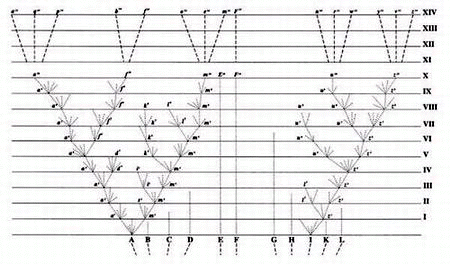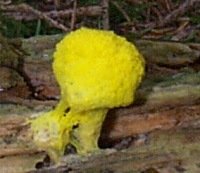Trees Birds Mammals Fish Amphibians Reptiles
Wild Algarve
Bookshop
Systematics, Evolution, and the Relationships between Living Organisms
In biology, the term systematics refers to the scientific study of life on Earth, how it has evolved, and the relationships, physical and genetic similarities and differences between organisms existing now and those that existed in the past. The traditional way of illustrating such relationships is a tree, where the branches stem from a common origin, splitting again and again until twigs terminate either in an extinct species or one existing today (an extant species).

The tree of life, reproduced from Darwin’s On the Origin of Species by Natural Selection, published in 1859
Taxonomy is another term for the study of the physical or morphological relationships, and taxa (the singular is a taxon) are the various kinds of living things that are organised into hierarchical groupings based on the degree of similarity of various features, or 'characters'.
Not all trees use the same convention, however. Cladistic trees - a 20th century concept - focus on evolutionary changes rather than current similarities between extant species. In some of the resulting trees, called cladograms, the branch length from a branching node, representing the most recent common ancestor of two or more successors, is a measure of time. Nodes cannot be observed today, of course, as they are a hypothetical diverging event - a viable mutation - in the distant past; nevertheless, DNA and RNA sequencing data and special computer programs are helping scientists to create cladograms with increasing confidence.
Because we have so few fossil records to help date the branching nodes on plant cladograms, and given the computational limitations of even the most powerful computers available today, cladistics cannot yet unravel all of Life's evolutionary mysteries; however, allied with traditional taxonomy this new science is certainly helping to improve our understanding of the evolutionary process that produced the biodiversity of species found on Earth today. Cladistics has already raised questions about many accepted classifications, several of which have indeed been found to be incorrect and have had to be revised. More such revisions are inevitable.
Modern biological classification is based on pioneering work by Swedish Botanist Carolus Linnaeus, who grouped species with similar physical characteristics. DNA sequencing data have resulted in revisions that align these groupings with Darwin's theory of common descendants - the theory of evolution - but in essence Linnaean classification is still used today.
Charles Darwin arranged all life forms into just two Kingdoms, the plants (Plantae) and the animals (Animalia). Recent genetic research based on RNA has led to a general acceptance of top-level domain groupings that separate out Bacteria, Archaea and Eukaryotes. At some time in the past these separations must have stemmed from single-celled, very primitive types of life form more akin to the Archaea than anything else known today. (There is some evidence that the Eukaryota may have evolved not just by mutations from primitive single-celled organisms but as new organisms created by the fusion of material from Bacteria and Archaea - suggesting tree branches that are able to rejoin.)
For our purposes here, we will ignore the Bacteria and Archaea but look in some detail at the third domain, the Eukaryota, because nearly all of the life forms that we can see, comprising four Kingdoms: the plants, animals, fungi and protists.
PROTISTA (Protists)
Protists are minute organisms, such as protozoa and algae. Algae live either in freshwater or in sea water and are capable of creating their own food by photosynthesis, but not all protists are able to synthesise their food.
 |
There are, for example, fungus-like protists known as Myxomycota or slime moulds; they are capable of absorbing nutrients from other living or dead plants, just as fungi and animals do.
What we see of a slime mould is in fact a mass of microscopic protists, but yet amazingly at one stage in their life cycle they are capable of coordinated amoeba-like movement across decaying wood or plants. Many of the most common slime moulds are brightly coloured, with yellow or orange ones being most conspicuous. |
METAPHYTA (Plantae)
The kingdom of Plantae includes all land-based plants such as ferns, mosses, trees and flowering plants. Most plants contain the green pigment chlorophyll, which gives them the ability to produce their own food by photosynthesis. Recent genetic studies suggest that the primitive (non-flowering) plants first appeared on Earth some 700 million years ago (more than 200 million years earlier than previous estimates based on fossil evidence), and fossil remains indicate that flowering plants began appearing just 130 million years ago, by which time there were already insects and mammals waiting to develop a linking for them!
Plants are essential to animal life; not only do they control the balance of gases in our atmosphere - most notably Carbon Dioxide, an excess of which would render the air unbreathable and its temperature way above what most animal life could ever survive, but flowering plants provide nearly all of our food as well as raw materials for our homes, clothes, medicines and so much more. The Plant Kingdom is now thought to contain something like 1/4 million species.
MYCOTA (Fungi)
The first fungi appeared on earth at least 1000 million years ago and possibly as early as 1200 million years ago. So far more than 100,000 species have been identified, but scientists believe there are probably around 1.5 million species of fungi still to be discovered, described and named. Lacking chlorophyll, fungi feed on other living or dead organisms.
In our Fungi section you will find much more about this little understood kingdom, the terminology used by mycologists (those who study fungi), how to identify many of the most commonly encountered species, and the way mushrooms, toadstools and other fungal forms are categorised.
METAZOA (Animalia)
We may never unravel enough genetic and fossil evidence to work out exactly the route by which animals evolved from lower life forms, but the kingdom of animals is in many ways more closely aligned with the kingdom of fungi than with plants. Fungi and animals need other living or dead organisms as a source of food; most plants can produce their own food provided they receive energy in the form of light from the sun. Scientists believe that the first very simple animals must have evolved about 600 million years ago, with insects, spiders and crustaceans appearing some 50 million years later, followed by fish, insects, amphibians, reptiles and eventually, mammals and birds. The genus Homo dates back something like 2.5 million years, and Homo sapiens has been around a mere 200,000 years or so. The last extinction from the Homo genus was Neanderthal man, about 25,000 years ago. It's our turn next!
The Linnaean Binomial System
By whichever route an organism is classified, the end result is that it is given a unique name and a scientific description. The names are formed from Latin or Greek words and the same words are used throughout the world, irrespective of the native language of the region. In this way a Chinese scientist will know for certain which specific creature, plant etc a Russian, British or Brazilian scientist is referring to. For example, Geranium pratense is the scientific name for the wildflower commonly known in Britain as Meadow Cranesbill. The name is always written in italics and comprises two parts, Geranium is the name of the genus, always written with a capital first letter; pratense is the specific name given to this member of the Geranium genus, and all specific names are written in lower case throughout. All other members of the same genus have names beginning Geranium and ending with unique specific names - for example Geranium lucidum is the scientific name for Shining Cranesbill.
Here is a hierarchical classification table for the Bee Orchid, Ophrys apifera:
| Kingdom: Plantae (plants), comprising 10 Phyla |
|
Phylum: Anthophyta (flowering plants), comprising two classes (Monocotyledonae, commonly referred to as Monocots; and Dicotyledonae, or Dicots). |
| |
Class: Monocotyledonae (having one cotyledon or immature leaf within its seed, leaves with parallel veins, and flowering parts in threes multiples of three), comprising 12 orders. Note that latterly the distinction between Dicots and Monocots has been shown to be of limited value, since Monocots almost certainly evolved from Dicots. |
 |
Order: Orchidales, containing plants with minute seeds, including at least two families - the Orchidaceae and the Burmanniaceae. |
| |
Family: Orchidaceae, containing some 24,000 known species (and rising!) in aproximately 1000 genera. |
| |
Genus: Ophrys (terrestrial orchid of temperate climates), containing more than 200 species. |
| |
Species: Ophrys apifera |
What are genera and families?
All members of the genus Geranium (the generic name referring to their seed-pods' long protrusions that are reminiscent of the long slim bills of cranes), together with closely related genera such as Pelargonium (the name coming from the greek words for a stork's bill) are grouped together at the next level up in the hierarchy as the family Geraniaceae, all of which have long beak-like fruit pods. Note that by convention family names are not italicised. The distinction between Geranium and Pelargonium species that puts them in separate flower genera is to do with the number of anthers or stamens (these terms explained in our Glossary): Geranium species have ten stamens while Pelargonium species have only seven.
What are species?
We have seen that overall there are seven major levels in the biological classification system: Kingdom, Phylum, Class, Order, Family, Genus, Species. You will also come across sub-divisions such as sub-order or sub-species - nothing, it seems, is ever kept tidy for long! But what exactly is a species? A simple definition is a taxonomic group whose members can interbreed to produce fertile offspring. But as life is continually evolving, how much can an organism mutate before it becomes a new species? We must leave that philosophical question to the scientists; for us here at First Nature, a species is a life form - plant, animal, fungus etc - having a unique and accepted scientific name and with barriers to successful reproduction with other species from the same genus or with species from other genera, families and higher levels in the hierarchy of life.
Top of page...
Sue Parker's latest ebook is a revised and enlarged edition of Wild Orchids in The Burren. Full details here...
Buy it for just £5.95 on Amazon...
Sue Parker's new ebook is a comprehensive and fully revised edition of her acclaimed field guide to the Wild Orchids of Wales. Full details here...
Buy it for just £5.95 on Amazon...
Please Help Us: If you have found this information interesting and useful, please consider helping to keep First Nature online by making a small donation towards the web hosting and internet costs.
Any donations over and above the essential running costs will help support the conservation work of Plantlife, the Rivers Trust and charitable botanic gardens - as do author royalties and publisher proceeds from books by Pat and Sue.